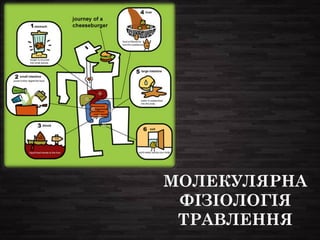
Molecular physiology of Digestive system
- 5. Reception vs perception (сприйняття vs відчуття) 1.солодкий 2.солоний 3.кислий 4.гіркий 5.умами («довершений») або саворі (чабер)
- 9. Polycystic kidney disease 2-like 1 protein also known as Transient receptor potential polycystic 3 (TRPP3) – cation-selective ion channels that are permeable to calcium PKD2L1
- 10. СМАКОВІ РЕЦЕПТОРИ • TAS1R (3 типи): солодке та умамі (ліганди – цукри та глутамат) • TAS2R (50 типів): гірке (ліганди –алкалоїди та біофлавоноїди) • PKD2L1: кисле (Са2+ канали, які активуються Н+) • ENaC: солоне (канали для іонів Na+) • GPR40, GPR120, GPR119: жирні кислоти
- 19. Extracellular recording system to trap adenosine triphosphate (ATP) released from a taste bud cell of α-gustducin–green fluorescence protein (Gust-GFP) mice Murata Y et al. J Neurophysiol 2010;104:896-901 ©2010 by American Physiological Society
- 25. Asp-Thr-Gly (Asp25, Thr26 and Gly27) sequence common to aspartic proteases ПЕПСИН – ЦЕ ТРАВЛЕННЯ
- 26. ДЕГРАДАЦІЯ (ПРОТЕОЛІЗ) БІЛКІВДЕГРАДАЦІЯ (ПРОТЕОЛІЗ) БІЛКІВ ОБМЕЖЕНИЙОБМЕЖЕНИЙ НЕОБМЕЖЕНИЙНЕОБМЕЖЕНИЙ ПОЗА-ПОЗА- КЛІТИННИЙКЛІТИННИЙ ВНУТРІШНЬО-ВНУТРІШНЬО- КЛІТИННИЙКЛІТИННИЙ ОБМЕЖЕНИЙОБМЕЖЕНИЙ НЕОБМЕЖЕНИЙНЕОБМЕЖЕНИЙ - активаціяактивація внутрішньоклітиннихвнутрішньоклітинних проферментів системипроферментів системи апоптозу, ПОМК та ін.апоптозу, ПОМК та ін. - активація проферментівактивація проферментів системи травлення, зсіданнясистеми травлення, зсідання крові,крові, -комплементу та ін.комплементу та ін. - перетравлення білківперетравлення білків у системі травленняу системі травлення - протеасомний протеолізпротеасомний протеоліз - лізосомний протеолізлізосомний протеоліз
- 28. Секреція HCl
- 29. МеханМеханізм секреціїізм секреції HClHCl
- 33. Загальна схема регуляції секреції HCl
- 34. CALCIUM-SENSING RECEPTOR (CaSR) - НОВИЙ КАНДИДАТ НА РОЛЬ ШЛУНКОВОГО ХЕМОСЕНСОРУ
- 35. C: overlay of stainings against CaSR (red) and the H+ -K+ -ATPase -subunit (green)β demonstrates expression of both proteins in the same cells. The calcium-sensing receptor acts as a modulator of gastric acid secretion in freshly isolated human gastric glands Matthias M. Dufner, Philipp Kirchhoff
- 36. Секреція бікарбoнату - HCO3 -
- 40. Секреція бікарбoнату - HCO3 -
- 42. UMAMI RECEPTOR ACTIVATION INCREASES DUODENAL BICARBONATE SECRETION … Wang JH, Inoue T, Higashiyama M, Guth PH, Engel E, Kaunitz JD, Akiba Y. J Pharmacol Exp Ther. 2011 Nov;339(2):464-73.
- 43. CCK – холецистокінін PYY- панкреатичний пептид YY GLP-1 – глюкагон-подібний пептид
- 50. CFTR - ion channel that transports chloride and thiocyanate ions (SCN– ) across epithelial cell membranes. МУКОВІСЦИДОЗМУКОВІСЦИДОЗ найбільш розповсюджене аутосомно-рецесивне захворювання людини (1 випадок на 2000-2500 новонароджених), що виникає внаслідок мутацій в гені CFTR (Cystic fibrosis transmembrane conductance regulator)
- 69. Ваші органи тішаться, коли ви дізнаєтесь щось нове та цікаве!
Editor's Notes
- Extracellular recording system to trap adenosine triphosphate (ATP) released from a taste bud cell of α-gustducin–green fluorescence protein (Gust-GFP) mice. A: merged confocal and differential interference contrast images around the stimulating pipette tip with a fungiform taste bud in the experimental setup. B: sample records from a GFP-positive taste bud cell. NaCl, 300 mM; saccharin (Sac), 20 mM; HCl, 10 mM; cyclohexamide (Chx), 500 μM; monosodium glutamate (MSG), 300 mM. C: representative ATP release from a GFP-positive (a) and -negative (b) taste bud cell by application of 20 mM Sac. Left: extracellular recording of electrical activity (arrowheads indicate offset of bath perfusion and onset of taste stimulation). Right: ATP concentration in the recording electrode solution measured by luciferase assay (N.D., not detectable; detection limit, 40 pM).
